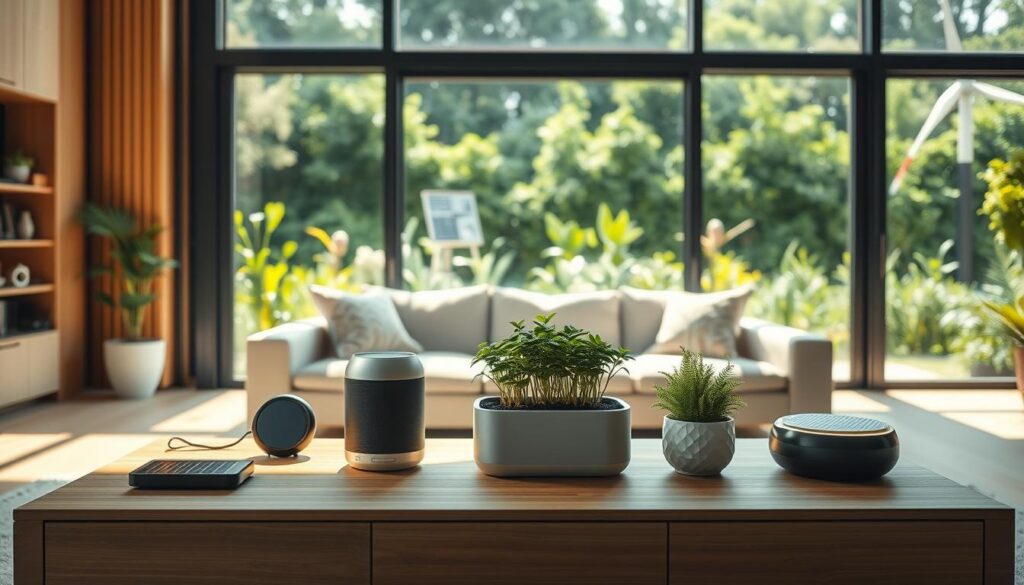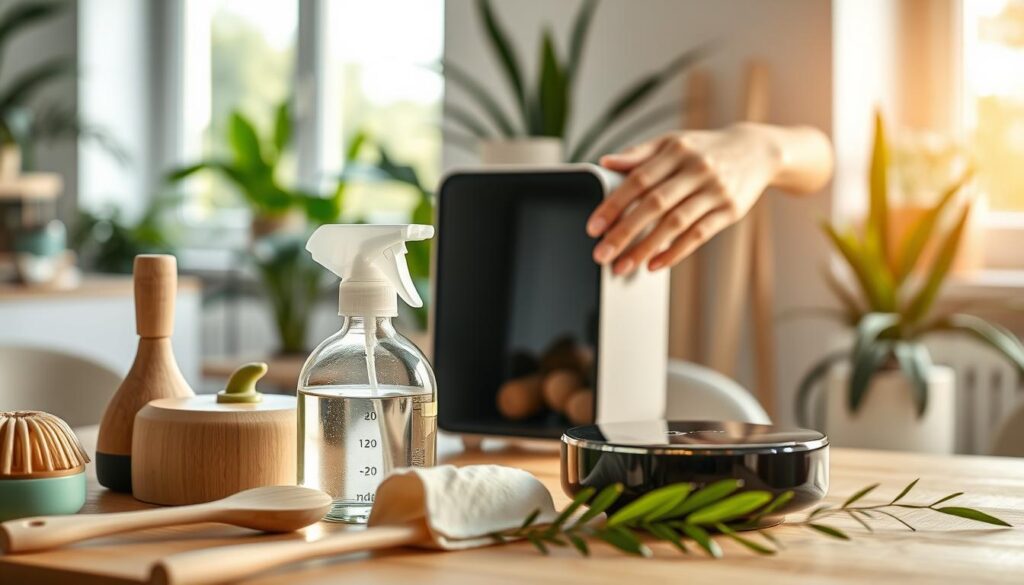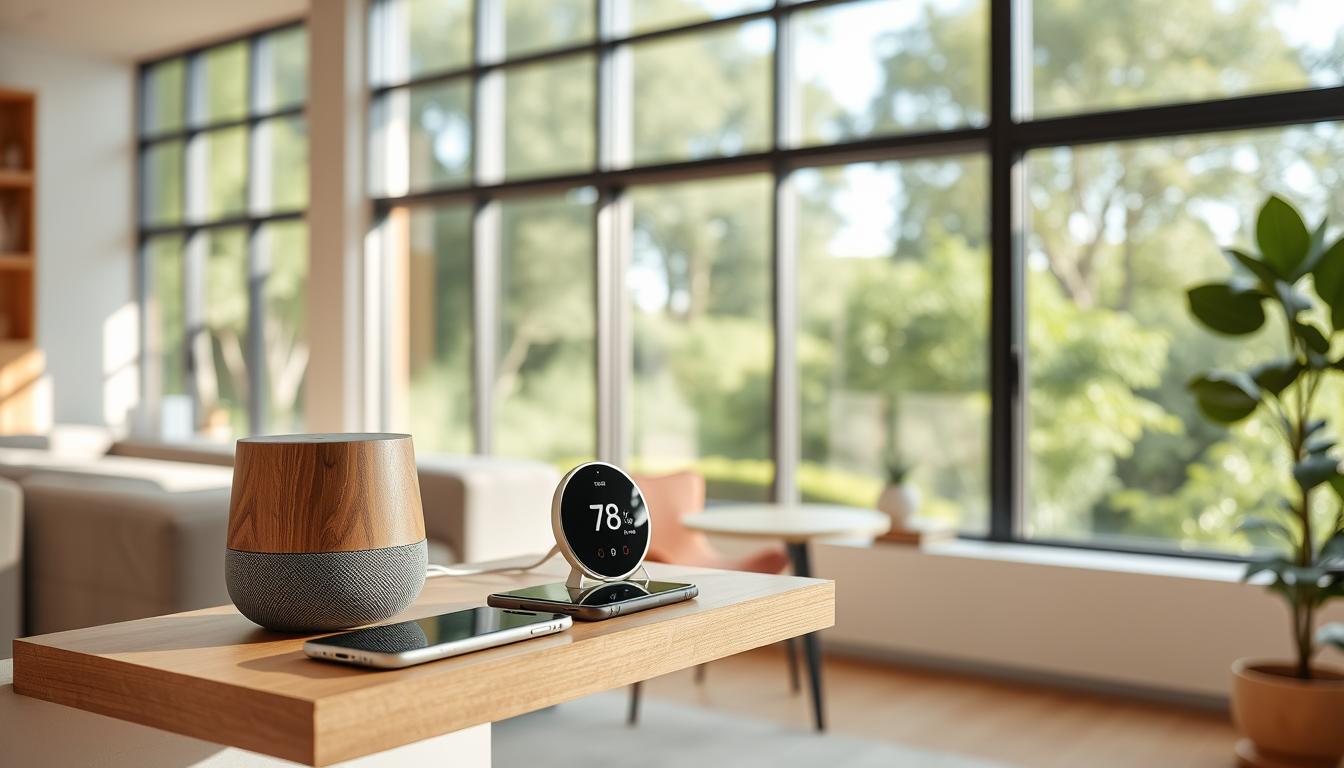Eco-friendly gadgets for home are reshaping everyday life. These devices cut energy use and reduce waste, proving sustainability and convenience go hand in hand. From solar lights to smart sensors, they help households protect the planet without giving up modern comforts. Every small choice matters, creating a ripple effect for a greener future.
Modern homes now embrace tech that prioritizes both performance and the environment. Energy-efficient appliances and reusable items like bamboo kitchenware or LED bulbs show how eco-friendly gadgets for home simplify living while minimizing harm. Innovations like smart plugs and water-saving faucets prove sustainability is achievable and accessible.
Key Takeaways
- Eco-friendly gadgets for home balance tech innovation with environmental care.
- They lower energy bills and reduce reliance on nonrenewable resources.
- Sustainable home tech includes items from lighting to kitchen tools.
- Small upgrades like LED bulbs or solar chargers have big environmental impacts.
- Smart choices today build a foundation for long-term ecological benefits.
Understanding the Rise of Eco-Friendly Gadgets for Home
From smart thermostats to solar-powered chargers, eco-friendly gadgets are reshaping how we live. Their popularity isn’t just a trend—it’s a response to global sustainability goals and consumer demand. Let’s break down why these innovations matter.
What Defines Eco-Friendliness
At its core, sustainable home technology prioritizes longevity, resource efficiency, and minimal environmental harm. Key traits include:
- Materials: Recycled plastics or bamboo in appliance designs.
- Energy Use: Solar-powered devices or models meeting Energy Star ratings.
- End-of-Life Plans: Brands like Philips offer take-back programs for safe disposal.
Benefits for Modern Living
These gadgets simplify life while protecting the planet. For instance, smart sensors adjust lighting and heating based on occupancy, cutting energy waste. A 2023 study by the American Council for an Energy-Efficient Economy found households using such tech can reduce bills by 20%. Health benefits shine too—air purifiers with HEPA filters improve indoor air quality, directly impacting well-being.
“Sustainable tech isn’t a compromise—it’s an upgrade,” says Dr. Lena Carter, a green tech researcher.
By choosing devices that align with these principles, homeowners turn daily routines into eco-conscious actions. The shift isn’t just about gadgets—it’s about rethinking how we live better, together.
Innovative Sustainable Home Technology Trends
Step into a world where innovation meets sustainability. The latest trends in sustainable home tech are redefining how green living products enhance daily life. From cutting-edge systems to stylish designs, these innovations prove eco-conscious choices can be both smart and stylish.
Emerging Technologies
Emerging tech is pushing boundaries in energy efficiency and resource management:
- Solar-powered gadgets: Tesla’s rooftop panels and portable chargers harness clean energy.
- Smart thermostats: Nest Learning Thermostat learns habits to slash heating/cooling waste.
- Water-saving systems: Brac Systems’ sensors cut household water use by up to 30%.
Innovative Design Trends
Designers are blending aesthetics with sustainability, creating green living products that inspire:
- Modular furniture: IKEA’s BILLY bookshelves adapt to space changes, reducing waste.
- Recycled materials: EcoBirdy toys transform plastic waste into colorful, durable playsets.
- Biophilic designs: Brands like Branch Home integrate living plants into decor for cleaner air.
“Innovation in green living products isn’t just about function—it’s about reimagining what’s possible.” — Sarah Green, Sustainability Designer at EcoTech Labs
| Category | Example | Brand |
|---|---|---|
| Technology | Solar-Powered Chargers | Tesla |
| Design | Modular Furniture | IKEA |
| Materials | Recycled Plastic Toys | EcoBirdy |
These trends highlight how green living products are no longer niche—they’re becoming essential for modern, eco-conscious homes.
Key Features of Green Living Products
When selecting environmentally friendly household devices, focus on features that blend sustainability with functionality. Look for products engineered to reduce resource use while maintaining performance.
Sustainable design isn’t just about today—it’s an investment in the planet’s future.
- Energy Efficiency: Appliances with ENERGY STAR ratings consume less power. For example, GE’s refrigerators use advanced insulation to cut energy use by up to 20%.
- Long-Lasting Materials: Durable builds minimize waste. Brands like Bosch use stainless steel and recycled plastics to extend product lifespans.
- Recycled Components: Many devices now incorporate post-consumer materials. Dyson vacuums, for instance, feature parts made from 30% recycled aluminum.
- Affordable Longevity: While upfront costs may be higher, savings on energy and repairs add up over time. Studies show eco-certified appliances save $100–$300 annually on utilities.
These traits ensure environmentally friendly household devices stay effective while aligning with eco-conscious goals. Prioritizing these aspects helps create a home that’s both functional and planet-friendly.
Smart Home Integration with Energy-Efficient Gadgets
Modern smart homes thrive when energy-efficient home gadgets work together. Systems like Nest thermostats or Philips Hue lighting automate energy use, saving resources while enhancing comfort. Pairing devices smartly ensures homes run smoothly without sacrificing sustainability.
Seamless Home Automation
Automation turns routine tasks into energy-saving habits. For example:
- Smart thermostats adjust heating based on room occupancy.
- Motion sensors dim lights in unused spaces.
- App controls let users monitor energy use in real time.
Integrating Multiple Devices
Compatibility bridges gaps between brands. Below is a quick guide to leading platforms:
| System | Supported Brands | Key Feature |
|---|---|---|
| Apple HomeKit | Nest, Philips Hue | iPhone/iPad control |
| Google Home | LG, Samsung SmartThings | Voice commands via Google Assistant |
Pairing these systems reduces setup complexity and maximizes savings.
Start small—add a smart plug to monitor a high-use appliance first. Over time, expand the network for full home optimization. The payoff? Lower bills and a greener footprint.
Benefits of Eco-Conscious Home Innovations
Switching to eco-conscious home innovations isn’t just good for the planet—it’s smart for your wallet and well-being. These upgrades cut energy use, lower bills, and boost comfort without sacrificing modern convenience.
- Cuts utility costs by up to 30% with energy-efficient appliances.
- Reduces water waste through smart irrigation systems and low-flow fixtures.
- Improves air quality with HEPA filters and non-toxic materials.
| Technology | Yearly Savings | Environmental Impact |
|---|---|---|
| Smart Thermostats | $180 saved | 2,000 lbs less CO2 emissions |
| Solar Panels | $600 saved | Eliminates 4,500 lbs of CO2 yearly |
“Eco-conscious upgrades pay for themselves over time while protecting natural resources,” says the U.S. Environmental Protection Agency.
Systems like Philips Hue LED lighting or LG’s ThinQ app-connected appliances merge style with sustainability. These choices lower monthly bills and create healthier spaces. Over time, homeowners see returns through lower maintenance and rising home value. Eco-conscious home innovations prove that doing right by the planet also means investing in your family’s future.
Designing a Greener Living Environment
Transform your space into a haven that’s both beautiful and eco-conscious. Integrating green tech for the home doesn’t mean sacrificing style—every choice can contribute to a healthier planet.

Eco-Friendly Home Design Ideas
- Choose reclaimed wood for floors and cabinetry. Brands like EcoTimber offer FSC-certified options that reduce waste.
- Install solar-powered outdoor lighting from companies like Renogy to cut energy use without sacrificing ambiance.
- Opt for smart thermostats such as Ecobee to automate heating and cooling, saving energy effortlessly.
Sustainable Decor Tips
- Bring in plants like peace lilies or ferns to naturally purify the air and add life to rooms.
- Use non-toxic paints. Benjamin Moore’s Natura line offers VOC-free colors that are safe and stylish.
- Upcycle furniture—transform old pallets into shelves or repaint secondhand pieces for a fresh look.
| Material | Pros | Cons | Best For |
|---|---|---|---|
| Bamboo Flooring | Rapidly renewable, durable | May dent under heavy furniture | Living rooms, bedrooms |
| Recycled Glass Tiles | Resistant to moisture, vibrant colors | Higher upfront cost | Kitchens, bathrooms |
Small changes make a big difference. Every step toward eco-friendly design moves your home closer to sustainability without losing personal style.
The Future of Environmentally Friendly Household Devices
Imagine a home where every device works in harmony with the planet. The future of sustainable living solutions is here, driven by innovation and consumer demand. From smarter energy use to zero-waste designs, upcoming trends promise greener homes without sacrificing convenience.
Advancements in Green Technology
Emerging tech is reshaping everyday items. Solar-powered Wi-Fi routers like those from SunPower and AI-driven thermostats such as Nest’s new eco-mode are cutting energy waste. Companies like Philips are testing biodegradable smartphone casings, proving tech can be both high-performing and planet-friendly. Innovations include:
- Batteries made from recycled materials
- Smart sensors that optimize water usage
- 3D-printed home accessories using plant-based plastics
Market Outlook
“By 2030, eco-friendly gadgets will dominate 40% of the home tech market.” — GreenTech Analytics Report 2023
Investments in sustainable living solutions are soaring. Analysts predict a $150 billion industry by 2030, fueled by stricter global emissions laws. Major retailers like Best Buy and Walmart are already expanding eco-device sections. Consumers now prioritize longevity and recyclability, pushing brands to innovate faster.
Stay ahead by exploring modular devices—like IKEA’s stackable appliances—that adapt as needs change. The future isn’t just about buying green—it’s about systems that last, learn, and evolve with you.
Real-World Success Stories with Green Tech for the Home
Across the U.S., households are proving eco home products work. In Austin, Texas, a family cut energy use 40% by switching to solar panels and smart thermostats. Their story shows how these tools save money while reducing carbon footprints.
“Installing a Nest thermostat and Philips LED bulbs transformed our home. Bills dropped, and the change felt effortless,” says Sarah, a homeowner in California.
Communities like Portland, Oregon, see collective impact. Over 200 homes in one neighborhood use Tesla Powerwalls, cutting grid reliance by 65%. These examples highlight how eco home products create tangible results.
Case studies also show health benefits. In Chicago, a family with allergies reduced chemical exposure by switching to non-toxic cleaners and air purifiers. Their story emphasizes safety alongside sustainability.
Real outcomes inspire action. From energy savings to cleaner air, these stories reflect the power of eco home products. Start small—like replacing bulbs or upgrading appliances—and see how green tech fits into daily life.
Tips for Maintaining and Upgrading Eco Home Products

Making your eco-friendly gadgets last longer means saving money and reducing waste. Start with basic upkeep to keep devices running efficiently. Here’s how to care for and improve your green tech over time.
Maintenance Best Practices
- Clean solar panels twice yearly with a soft brush and water to maximize energy absorption.
- Check smart thermostats like Nest Learning Thermostat for firmware updates to optimize energy use.
- Store rechargeable batteries in a cool, dry place to extend their lifespan.
Upgrading Tips
When it’s time for new tech, prioritize Energy Star-certified models. Look for devices with modular designs, such as Philips Hue bulbs that let you replace parts instead of the whole system. Recycling old gear through programs like Best Buy’s Trade-In ensures components are responsibly disposed of.
“Proper maintenance can boost appliance efficiency by up to 20%,” says the U.S. Department of Energy.
Pair older eco gadgets with smart hubs like Samsung SmartThings to integrate them into modern systems. Always verify compatibility before buying accessories.
How to Select the Best Energy-Efficient Home Gadgets
Picking the right energy-efficient gadgets starts with knowing what to look for. Here’s how to simplify the process and find products that save energy and money.
Performance Benchmarks
Check labels like Energy Star or LEED certification. These certifications confirm a product meets strict efficiency standards. Look for specs like kWh usage and annual energy savings listed on packaging or websites. For example, refrigerators with low kWh ratings cut electricity bills over time.
- Compare energy labels (A+++ to G) for appliances.
- Choose devices with smart sensors to turn off when not in use.
User Reviews
“My LED lights cut my bill by 30% after six months.”
Read reviews focusing on real-world energy savings and durability. Prioritize feedback from users with similar lifestyles. Watch for common complaints like overheating or frequent replacements.
- Search for terms like “long-term performance” or “cost savings” in reviews.
- Avoid gadgets with frequent repair mentions or short warranties.
Pair technical data with user experiences to pick gadgets that balance efficiency and reliability. Start with certified products, then validate claims through reviews to make smart choices.
Choosing Eco-friendly gadgets for home
Picking the right eco-friendly gadgets starts with clear goals. Look for products that balance style, function, and sustainability. Here’s how to make smart choices:
- Check energy ratings: Look for Energy Star-certified devices like Philips LED bulbs or Nest thermostats. These use less power without sacrificing performance.
- Material matters: Opt for brands using recycled or biodegradable parts, such as LG’s eco-mode appliances.
- Read certifications: Labels like Cradle to Cradle or RoHS ensure gadgets meet strict environmental standards.
| Factor | Why It Matters |
|---|---|
| Energy efficiency | Cuts bills and reduces carbon footprints. |
| Longevity | Products designed to last minimize waste. |
| Recycling programs | Brands offering take-back schemes, like Dell’s e-waste initiative, help close the loop. |
“Small choices today shape a greener tomorrow.”
Ask retailers about disposal plans and repair options. Prioritize multi-functional devices to reduce clutter. By focusing on these steps, every purchase becomes part of a larger sustainable effort. Start small—like swapping old lights with smart bulbs—and build from there. Every decision counts toward a home that’s both tech-savvy and planet-conscious.
Conclusion
Making your home greener starts with eco-friendly gadgets that blend sustainability with style. From energy-efficient lighting to smart home automation systems, these innovations save resources without sacrificing convenience. Brands like Philips and Nest lead the way, offering products that cut waste and lower bills while supporting a healthier planet.
Sustainable home technology isn’t just a trend—it’s a path to smarter living. By choosing energy-efficient home solutions, you join a movement where every small choice matters. Whether upgrading to solar-powered devices or adopting reusable tech, each decision adds up to a bigger impact. Companies like LG and Ecovative Design prove that style and sustainability go hand in hand, making eco-friendly living attainable for all.
Explore options like smart thermostats or biodegradable appliances today. Small steps like swapping old devices with green living products create lasting change. Together, these choices build a future where technology and nature thrive in balance. Start exploring your eco-friendly upgrades now—your home and the planet will thank you.
FAQ
What are eco-friendly gadgets for home?
Eco-friendly gadgets for home are devices designed to reduce energy consumption, minimize waste, and promote sustainable practices within your living space. These environmentally friendly household devices are often made from sustainable materials and are energy-efficient, contributing significantly to green living.
How do I know if a gadget is energy-efficient?
To determine if a gadget is energy-efficient, look for certifications like ENERGY STAR, which signifies that the product meets energy efficiency guidelines set by the U.S. Environmental Protection Agency. Additionally, check for user reviews and performance benchmarks that highlight its energy-saving capabilities.
What are some examples of sustainable home technology?
Examples of sustainable home technology include smart thermostats, solar-powered chargers, LED lighting, and water-saving appliances. These innovations not only enhance efficiency but also contribute to a more eco-conscious lifestyle, reducing your home’s overall carbon footprint.
Why should I invest in green living products?
Investing in green living products helps reduce your environmental impact, lowers energy bills, and often leads to long-term savings. These products promote eco-friendly habits and enhance your lifestyle by creating a healthier living environment.
Can I integrate eco-friendly gadgets into my smart home system?
Yes! Many eco-friendly gadgets are designed to seamlessly integrate with smart home systems, providing automated monitoring and control. Smart plugs, energy monitors, and app-controlled lighting systems can help optimize energy use and enhance convenience in your daily routine.
How can I maintain my eco home products?
To maintain your eco home products, follow the manufacturer’s maintenance best practices, which may include regular cleaning, software updates, and troubleshooting performance issues. Proper care ensures longevity and optimal energy efficiency of your devices.
Where can I find sustainable decor tips for a greener living environment?
You can find sustainable decor tips from various online resources, eco-focused blogs, and home design magazines. Look for ideas that emphasize using recycled or upcycled materials, plants for natural air purification, and non-toxic paints and finishes that contribute to a healthier home.
What should I consider when choosing eco-friendly gadgets for my home?
When choosing eco-friendly gadgets for your home, consider factors such as energy efficiency ratings, durability, the materials used in production, and customer reviews. Creating a checklist of these key attributes can help you make informed decisions that align with your sustainable living goals.
